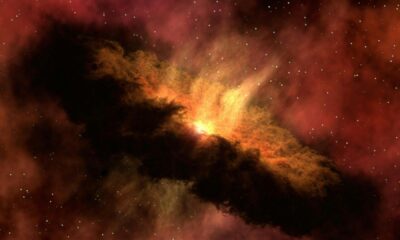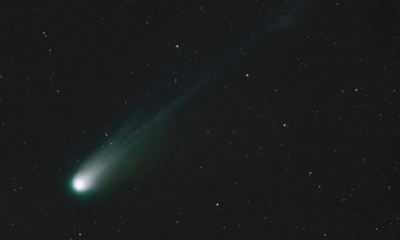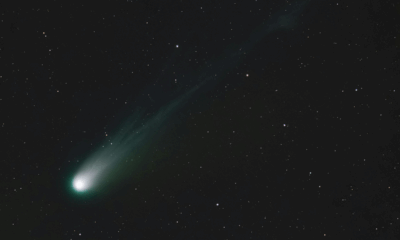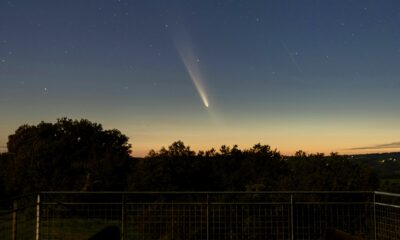Science
Scientists Trace Origin of Mysterious Deep Space Signal
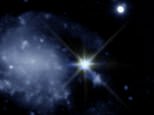
Scientists have identified the source of a mysterious radio burst originating from deep space, pinpointing an unknown object in the nearby galaxy NGC 4141. This significant discovery was made by a collaborative team from the Harvard & Smithsonian Center for Astrophysics and McGill University, revealing that one of the brightest fast radio bursts (FRBs) detected to date came from this galaxy, located approximately 130 million light-years from Earth.
Fast radio bursts are intense, brief emissions of radio waves lasting only a few milliseconds. They are believed to result from extreme cosmic events, such as the catastrophic explosions of massive stars, known as supernovae, which leave behind highly dense, magnetic neutron stars referred to as magnetars. In recent years, some scientists have speculated that these bursts could potentially be artificial in nature, possibly generated by advanced extraterrestrial technologies.
The burst, designated FRB 20250316A, or ‘RBFLOAT’, was detected in March 2025. It is notable for being the first FRB accurately traced to a specific location within a neighboring galaxy. The research team utilized the James Webb Space Telescope (JWST) to observe a faint infrared light, named NIR-1, which could reveal the underlying source of the radio signal.
Significant Advances in Astronomy
Mawson Sammons, a postdoctoral researcher at McGill University, expressed excitement over the findings, stating, “This marks the beginning of a new era where we can routinely localize even single, non-repeating bursts to pinpoint precision.” This development is expected to enhance the understanding of the phenomena behind FRBs.
The signal was traced to an area in the outskirts of NGC 4141, which is relatively close compared to other FRBs that have been detected from billions of light-years away. The discovery was facilitated by the Canadian radio telescope CHIME, which was recently upgraded with additional telescopes, allowing for greater accuracy in locating these rare bursts. The telescopes, referred to as ‘outrigger’ telescopes, span across North America, from British Columbia to California, enabling astronomers to pinpoint the source with remarkable precision.
Edo Berger, a professor of astronomy at Harvard, commented on the implications of the discovery, noting, “Being able to isolate individual stars around an FRB is a huge gain over previous searches.” He emphasized that this breakthrough will help researchers understand the types of stellar systems capable of producing such powerful bursts.
Exploring the Potential Causes
The nature of fast radio bursts like RBFLOAT is still under investigation, with several theories proposed regarding their origins. NIR-1 may represent a red giant star nearing the end of its life cycle, which has expanded and brightened. Researchers suggest this star might harbor an unseen companion, such as a magnetar, which could trigger an FRB by drawing material from the dying red giant.
Another possibility is that the FRB originated from a magnetar within a nearby cluster of young, massive stars, despite the magnetar itself being too faint to be directly observed from Earth. A third theory posits that the infrared light observed could be a fading ‘echo’ from the burst itself rather than from a star, prompting researchers to monitor its brightness in future observations.
Currently, while fast radio bursts are generally believed to stem from natural sources, the notion that they could be signals from extraterrestrial civilizations persists in scientific discussions. Amanda Cook, a postdoctoral researcher at McGill, stated, “This result marks a turning point: instead of just detecting these mysterious flashes, we can now see exactly where they’re coming from.” Her remarks encapsulate the excitement surrounding the potential to uncover whether these bursts are caused by dying stars, exotic magnetic objects, or phenomena that have yet to be understood.
As researchers continue to study FRBs, the findings from NGC 4141 represent a significant leap forward in the quest to decode the mysteries of the universe.
-

 Entertainment2 months ago
Entertainment2 months agoAnn Ming Reflects on ITV’s ‘I Fought the Law’ Drama
-

 Entertainment3 months ago
Entertainment3 months agoKate Garraway Sells £2 Million Home Amid Financial Struggles
-

 Health2 months ago
Health2 months agoKatie Price Faces New Health Concerns After Cancer Symptoms Resurface
-

 Entertainment2 months ago
Entertainment2 months agoCoronation Street’s Carl Webster Faces Trouble with New Affairs
-

 Entertainment2 months ago
Entertainment2 months agoWhere is Tinder Swindler Simon Leviev? Latest Updates Revealed
-

 Entertainment3 months ago
Entertainment3 months agoKim Cattrall Posts Cryptic Message After HBO’s Sequel Cancellation
-

 Entertainment2 months ago
Entertainment2 months agoOlivia Attwood Opens Up About Fallout with Former Best Friend
-

 Entertainment2 months ago
Entertainment2 months agoMasterChef Faces Turmoil as Tom Kerridge Withdraws from Hosting Role
-

 Entertainment3 months ago
Entertainment3 months agoMarkiplier Addresses AI Controversy During Livestream Response
-

 Entertainment4 months ago
Entertainment4 months agoSpeculation Surrounds Home and Away as Cast Departures Mount
-

 World2 months ago
World2 months agoCole Palmer’s Mysterious Message to Kobbie Mainoo Sparks Speculation
-

 Entertainment2 months ago
Entertainment2 months agoITV’s I Fought the Law: Unraveling the True Story Behind the Drama

